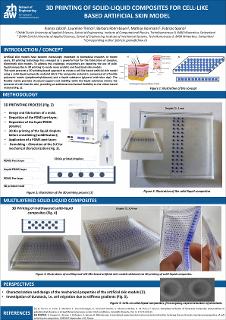Bitte benutzen Sie diese Kennung, um auf die Ressource zu verweisen:
https://doi.org/10.21256/zhaw-30588| Publikationstyp: | Konferenz: Poster |
| Art der Begutachtung: | Peer review (Abstract) |
| Titel: | 3D printing of solid liquid composites for cell-like based artificial skin model |
| Autor/-in: | Cabral, Kianna Thiriot, Laureline Röhrnbauer, Barbara Bonmarin, Mathias Spano, Fabrizio |
| et. al: | No |
| DOI: | 10.21256/zhaw-30588 |
| Angaben zur Konferenz: | 33rd Annual Conference of the European Society for Biomaterials (ESB), Davos, Switzerland, 4-8 September 2023 |
| Erscheinungsdatum: | 4-Sep-2023 |
| Verlag / Hrsg. Institution: | ZHAW Zürcher Hochschule für Angewandte Wissenschaften |
| Sprache: | Englisch |
| Schlagwörter: | Skin model; 3D bioprinting; Solid liquid composites |
| Fachgebiet (DDC): | 610.28: Biomedizin, Biomedizinische Technik |
| Zusammenfassung: | Artificial skin models have become increasingly important in biomedical research. In recent years, 3D printing technology has emerged as a powerful tool for the fabrication of complex, biomimetic skin models. To address this challenge, researchers are exploring the use of solid-liquid composites in 3D printing to create more realistic and functional skin models. Therefore, the development of a skin model using a solid-liquid composite is an attractive approach to bridge the gap between the two types of models. This work presents a 3D printing-based approach to create a cell-like based artificial skin model using a solid-liquid composite material. The composite material is composed of a flexible polymeric matrix (polydimethylsiloxane) and a liquid substance (glycerol with blue dye). The flexible matrix provides structural support and stability, while the liquid substance mimics the presence of cells into the skin, providing an additional mechanical flexibility to the silicon-based material. Based on a previous development of the encapsulation of droplets into unpolymerized silicon-based material, here the 3D printing process allows for precise control over the architecture and composition of the skin model, enabling the creation of multilayered complex structures with cell-like arrangements (Figure 1). The printing process also allows for the incorporation of different substances, different sizes and densities of droplets and droplet arrangements. In a next step, even the incorporation of multiple cell types, such as keratinocytes and fibroblasts, to create a more realistic and functional skin model would be considered. We expect for the resulting skin model to exhibit characteristics like human skin, including mechanical flexibility. Overall, the 3D printing of solid-liquid composites for a cell-like based artificial skin model provides a promising platform for the development of a realistic and functional skin model that can be used for a range of applications, including tissue engineering and durotaxis. The approach described in this work provides a foundation for further optimization and development of skin models using solid-liquid composites. While there are still challenges associated with achieving optimal printing parameters, the potential benefits of these models make them an exciting area of research for the future. In parallel to the development of these 3D printed cell-like based skin models, additional experimental and computational works have been realized elsewhere to characterize the influence of the encapsulated droplets on the local mechanical properties of the obtained material. |
| URI: | https://digitalcollection.zhaw.ch/handle/11475/30588 |
| Volltext Version: | Publizierte Version |
| Lizenz (gemäss Verlagsvertrag): | Keine Angabe |
| Departement: | School of Engineering |
| Organisationseinheit: | Institut für Mechanische Systeme (IMES) Institute of Computational Physics (ICP) |
| Enthalten in den Sammlungen: | Publikationen School of Engineering |
Dateien zu dieser Ressource:
| Datei | Beschreibung | Größe | Format | |
|---|---|---|---|---|
| 2023_Cabral-etal_3D-printing-of-solid-liquid-composites_ESB2023-Poster.pdf | 3.9 MB | Adobe PDF |  Öffnen/Anzeigen |
Zur Langanzeige
Cabral, K., Thiriot, L., Röhrnbauer, B., Bonmarin, M., & Spano, F. (2023, September 4). 3D printing of solid liquid composites for cell-like based artificial skin model. 33rd Annual Conference of the European Society for Biomaterials (ESB), Davos, Switzerland, 4-8 September 2023. https://doi.org/10.21256/zhaw-30588
Cabral, K. et al. (2023) ‘3D printing of solid liquid composites for cell-like based artificial skin model’, in 33rd Annual Conference of the European Society for Biomaterials (ESB), Davos, Switzerland, 4-8 September 2023. ZHAW Zürcher Hochschule für Angewandte Wissenschaften. Available at: https://doi.org/10.21256/zhaw-30588.
K. Cabral, L. Thiriot, B. Röhrnbauer, M. Bonmarin, and F. Spano, “3D printing of solid liquid composites for cell-like based artificial skin model,” in 33rd Annual Conference of the European Society for Biomaterials (ESB), Davos, Switzerland, 4-8 September 2023, Sep. 2023. doi: 10.21256/zhaw-30588.
CABRAL, Kianna, Laureline THIRIOT, Barbara RÖHRNBAUER, Mathias BONMARIN und Fabrizio SPANO, 2023. 3D printing of solid liquid composites for cell-like based artificial skin model. In: 33rd Annual Conference of the European Society for Biomaterials (ESB), Davos, Switzerland, 4-8 September 2023. Conference poster. ZHAW Zürcher Hochschule für Angewandte Wissenschaften. 4 September 2023
Cabral, Kianna, Laureline Thiriot, Barbara Röhrnbauer, Mathias Bonmarin, and Fabrizio Spano. 2023. “3D Printing of Solid Liquid Composites for Cell-like Based Artificial Skin Model.” Conference poster. In 33rd Annual Conference of the European Society for Biomaterials (ESB), Davos, Switzerland, 4-8 September 2023. ZHAW Zürcher Hochschule für Angewandte Wissenschaften. https://doi.org/10.21256/zhaw-30588.
Cabral, Kianna, et al. “3D Printing of Solid Liquid Composites for Cell-like Based Artificial Skin Model.” 33rd Annual Conference of the European Society for Biomaterials (ESB), Davos, Switzerland, 4-8 September 2023, ZHAW Zürcher Hochschule für Angewandte Wissenschaften, 2023, https://doi.org/10.21256/zhaw-30588.
Alle Ressourcen in diesem Repository sind urheberrechtlich geschützt, soweit nicht anderweitig angezeigt.